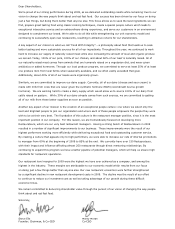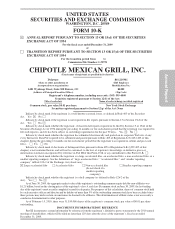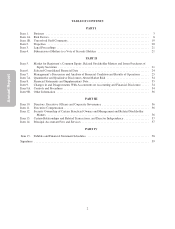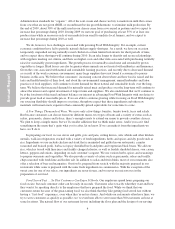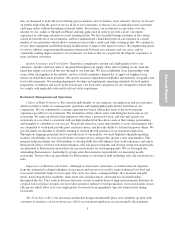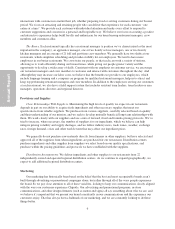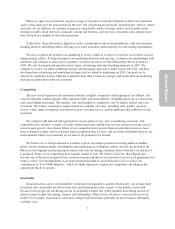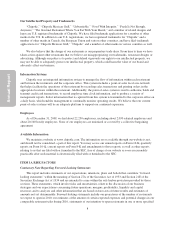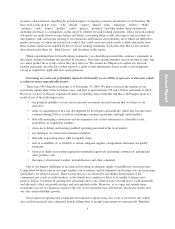Chipotle 2009 Annual Report Download - page 12
Download and view the complete annual report
Please find page 12 of the 2009 Chipotle annual report below. You can navigate through the pages in the report by either clicking on the pages listed below, or by using the keyword search tool below to find specific information within the annual report.
our growth strategy and the substantial investment associated with the development of each new restaurant (as
well as the impact of our new restaurants on the sales of our existing restaurants) may cause our operating results
to fluctuate and be unpredictable or adversely affect our profits.
Our sales and profit growth could be adversely affected if comparable restaurant sales increases are less
than we expect, and we may not successfully increase comparable restaurant sales.
While future sales growth will depend substantially on our opening new restaurants, changes in comparable
restaurant sales (which represent the change in period-over-period sales for restaurants beginning in their 13th
full month of operations) will also affect our sales growth and will continue to be a critical factor affecting profit
growth. This is because the profit margin on comparable restaurant sales is generally higher, as comparable
restaurant sales increases enable fixed costs to be spread over a higher sales base. Conversely, declines in
comparable restaurant sales can have a significant adverse effect on profitability due to the loss of the higher
profit margins associated with comparable restaurant sales. Comparable restaurant sales increases decelerated
during 2009, and we expect comparable restaurant sales in 2010 to be flat due to the impact of ongoing weakness
in consumer spending as a result of the economy and losing the impact of menu price increases we implemented
beginning in late 2008. If the economy remains weak or further weakens, we may further lower our expectations
for comparable restaurant sales.
In addition, our ability to increase comparable restaurant sales depends on many factors, including:
• changes in consumer preferences and discretionary spending, including weaker consumer spending in
difficult economic times, such as those that persisted throughout 2009;
• consumer understanding and acceptance of the Chipotle experience;
• our ability to increase menu prices without adversely impacting transaction counts to such a degree that
the impact of the decrease in transactions equals or exceeds the benefit of the menu price increase;
• competition, either from our competitors in the restaurant industry, or from our own restaurants as
some customers who frequent one of our restaurants may begin to visit one of our new restaurants
instead;
• other impacts of changes in general economic conditions, which can affect local labor costs and prices
we pay for the ingredients and other supplies we use;
• executing our strategies effectively, including our development strategy, our marketing and branding
strategies, our initiatives to increase the speed at which our crew serves each customer, and expanded
use of fax service lines and online ordering, each of which we may not be able to accomplish;
• initial sales performance of new restaurants, which is subject to the risks described below under “Our
new restaurants, once opened, may not be profitable, and may adversely impact the sales of our
existing restaurants”;
• weather, road construction and other factors limiting access to new restaurants; and
• changes in government regulation.
A number of these factors are beyond our control. As a result of these factors it is possible that we will not
achieve our targeted comparable restaurant sales or that the change in comparable restaurant sales could be
negative. If this were to happen, sales and profit growth would be adversely affected and our stock price would
be likely to decline.
Our new restaurants, once opened, may not be profitable, and may adversely impact the sales of our
existing restaurants.
Historically, many of our new restaurants have opened with an initial ramp-up period typically lasting
24 months or more, during which they generated sales and income below the levels at which we expect them to
10
Annual Report


